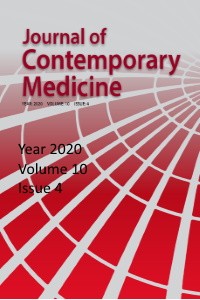Sigara İçen ve İçmeyen Yetişkinlerin Ekspiryum Havasındaki Karbonmonoksit Düzeylerinin Bağımlılık Puanları ile İlişkisinin Değerlendirilmesi
Abstract
Amaç: Sigara; psikolojik etkenler ve alışkanlıklar ile birlikte kişilerde bağımlılığa yol açmaktadır. Bağımlılığının düzeyi Fagerström Nikotin Bağımlılık Testi(FNBT)ile klinik uygulamalarda belirlenmektedir. Ekspiryum havasında CO düzeyi ölçümü bağımlılığın tanı, tedavi ve takip aşamalarında biomarker olarak günümüzde sıkça kullanılmaktadır. Bu çalışmada sigara içen hastaların CO düzeyleri ile FNBT arasındaki ilişkinin değerlendirilmesi amaçlandı.
Gereç ve Yöntem: Selçuk Üniversitesi Tıp Fakültesi Aile Hekimliği Polikliniği’ne Ağustos 2018-aralık 2019 tarihleri arasında gelen sigara içen ve sağlıklı gönüllülere anket uygulandı. 68 sigara içen hasta 60 sigara içmeyen gönüllü alındı. Hastaların sosyodemografik özellikleri, sigaraya başlama yaşı, ekspiryum havasındaki CO seviyeleri, solunum fonksiyon testi (SFT) sonuçları ve Nikotin Bağımlılığı için FNBT skorları kaydedildi. FNBT skorları ile ekspiryum havasındaki CO seviyeleri arasındaki ilişki araştırıldı. SPSS 22.0 programı kullanıldı.
Bulgular: Çalışmadaki kişilerin %60,9’u erkek %39,1’i ise kadın olup yaş ortamaları ise 53,0±6,9yıldır. Katılımcıların cinsiyet, yaş, meslek özellikleri ve medeni durum ile sigara içme durumu arasında istatistiksel olarak anlamlı bir fark bulundu. Sigara içenlerin FNBT skoru 5,00±2,44 puan olarak bulundu. CO düzeyi ile FNBT puanları arasında pozitif korelasyon olup bu durum istatistiksel olarak anlamlı bulundu. CO düzeyi ile FEV1/FVC düzeyleri arasında ise negatif korelasyon olup bu durum istatistiksel olarak anlamlı bulundu.
Sonuç: Nikotin bağımlılık düzeyini ölçen ölçekler arasında günümüzde sigara bıraktırma kliniklerinde en çok kullanılanı FNBT’dir. Bizim çalışmamızda birçok çalışmada olduğu gibi CO
seviyeleri ile FNBT skorları arasında pozitif korelasyon bulunup bu durum istatistiksel olarak anlamlı bulundu. CO düzeyleri sigarayı bırakma ve motivasyon yönetimi için bizlere FNBT puanı kadar rehberlik edebilir ve klinikte kullanılabilir. Çok merkezli ve daha geniş kitlelerde uzun zamanlı takip ile yapılacak çalışmaların konu ile ilgili daha yararlı bilgiler verebileceğini düşünüyoruz
Keywords
Supporting Institution
yoktur
Project Number
yoktur
References
- Referans 1 U.S. EPA. Air quality criteria for carbon monoxide Final Report, 2000. Washington, DC. U.S. Environmental Protection Agency, Office of Research and Development, National Center for Environmental Assessment, Washington Office. EPA, 600/P-99/001F, 2000.
Assessment of the Relationship Between Smoking and Non-Smoking Adults' Carbonmonoxide Levels in Expiratory Air with Dependency Scores
Abstract
Objectıve: Smoking; along with psychological factors and habits, it causes addiction in people. The level of smoking addiction is determined in clinical practices with the Fagerström Test for Nicotine Dependence (FTND). CO level measurement in expiratory air is frequently used today as a biomarker in the diagnosis, treatment and follow-up stages of addiction. In this study, it was aimed to evaluate the relationship between CO levels and FTND of smokers.
Materials and Methods: The questionnaire was applied to smokers and healthy volunteers coming to the Selcuk University Faculty of Medicine Family Practice Clinic. 68 smoker patients and 60 non-smoker volunteers were included. Patients' sociodemographic characteristics, age of starting smoking, CO levels in expiratory air and FTND scores were recorded. The relationship between FTND scores and CO levels in expiratory air was investigated. Chi-square test was used to examine the comparison of categorical data. P value p<0,05 was considered statistically significant.
Results: The mean age of the individuals included in the scope of the study was 53.0±6.9 and 39.1% of them were women, 60.9% of them were men. There was a statistically significant difference was found between the participants' gender, age, occupational characteristics and marital status and smoking status. FNBT score of smokers was found to be 5.00 ± 2.44 points. The average number of cigarettes smoked/year was 31.00±17.87 years, the average number of cigarettes smoked per day was 20.00±8.76 and the average age to start smoking was 18.00±4.82. There was a positive correlation between the CO results and FTND scores (p≤0.001). There was a negative correlation between the CO results and FEV1/FVC scores(p≤0.001).
Conclusıon: Among the scales that measure nicotine addiction level, FTND is the most used one in smoking cessation clinics today. In our study, there was a positive correlation between CO levels and FTND scores, which was found statistically significant. Measuring CO during patient follow-up is both an objective criterion for evaluating smoking cessation and enhances patient compliance. Therefore, CO levels can also be used as a guiding factor in determining the severity of cigarette addiction.
Keywords: Addiction, Carbonmonoxide, Smoking.
Keywords
Project Number
yoktur
References
- Referans 1 U.S. EPA. Air quality criteria for carbon monoxide Final Report, 2000. Washington, DC. U.S. Environmental Protection Agency, Office of Research and Development, National Center for Environmental Assessment, Washington Office. EPA, 600/P-99/001F, 2000.
Details
| Primary Language | English |
|---|---|
| Subjects | Health Care Administration |
| Journal Section | Original Research |
| Authors | |
| Project Number | yoktur |
| Publication Date | December 30, 2020 |
| Acceptance Date | September 9, 2020 |
| Published in Issue | Year 2020 Volume: 10 Issue: 4 |


